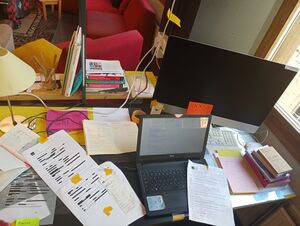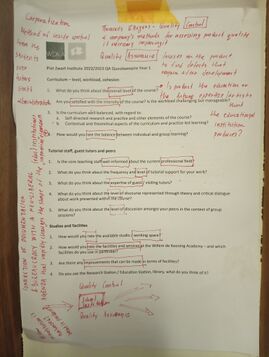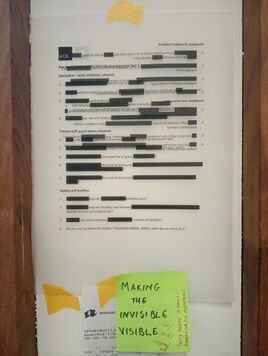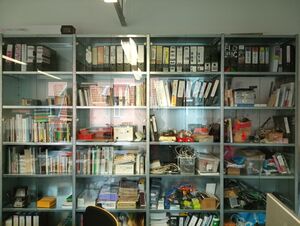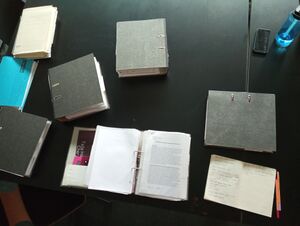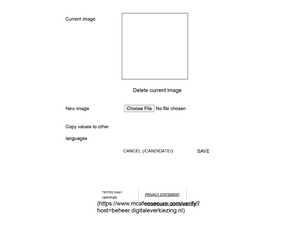Thesis, STORIES OF(DIS)PLACEMENT AND BUREAUCRACY, performing the papaerwork borderline
T H E S I S O U T L I N E
Working with the thesis - T E X T
Session 1 Seminar Thesis
1 What do you want to make?
I would like to explore the bureaucratic rituals inside the educational institution I am currently part as a master’s student. The case of wdka. How bureaucratic rituals change through years inside this institution and how (or if) these changes are related at some point with european/dutch policies around (migration) movement and border/migration control? How the transformation of the institution itself is depicted/implied through/in bureaucracy or established by these kind of dramaturgies. What are these dramaturgies about? My intention is to navigate, access and look through the administration documents, the bureaucratic ritualist apparatus, the way this apparatus usually looks at me, inside my (privileged) soul and other’s people souls. How bureaucracy constitute a border that needs to be performed and what does it mean not to be performed efficiently. The grey cold zone of visibility/invisibility of this border, the vulnerability created and the urgency to start putting it again on the table.
What do you mean the document is not universal and neutral?
There is no document of civilisation which is not at the same time a document of barbarism , Benjamin
2 How do you plan to make it?
I am planning to do a small field research by collecting and looking through the archive of documents that administration holds through the years and dive into the plain text and the structure of these paperwork. What made the potential students to become officially students and what went wrong with the ones that didn’t make it? How the amount of the paperwork changes and to which direction? What does it happen with the validity of the documents and who is in charge of? Try to find a brief history of the requirements and to become as student and the
3 What is your timetable?October
4 Why do you want to make it?
5 Who can help you and how?
6 Relation to previous practice
7 Relation to a larger context
8 Potential References/bibliography
- Archive Public
- Archive : Ariella Azoulay
- The dispossessed Ursula Le Guin
- Peter Principle
- The hopeless university
- Bourdieu: a social critique of judgment of taste
- writing machines katharine hayles
- (A cyborg manifesto Donna haraway)
- Archive Fever: a freudian impression Deridda
- (Forced) Movement
- Madeline Gins The Saddest Thing is that I Have Had to Use Words
- Karen Brodine Woman Sitting at the machine Thinking
- Radical Administration Festival brochure 2020
- Ursula Biemann Perrforming the Border documentary
- The Utopia of Rules: On Technology, Stupidity, and the Secret Joys of Bureaucracy, David Graeber
- the castle kafka
- Governing Asylum without “Being There”: Ghost Bureaucracy, Outsourcing, and the Unreachability of the State
- Ruben Pater CAPS - the good citizen
- The Tyrany of transparency Marilyn Strathern
- https://www.mdpi.com/2076-0760/12/3/169
- Ariella Azouay Un-Documented – Unlearning Imperial Plunder documentary
possibly useful links
- https://www.government.nl/topics/asylum-policy/tackling-the-refugee-problem
- https://www.government.nl/topics/asylum-policy/tackling-the-refugee-problem/support-to-greece-for-unaccompanied-minors
- https://asylumineurope.org/wp-content/uploads/2017/03/report-download_aida_nl_update.v_final.pdf
- https://greece.refugee.info/en-us/articles/4984594750615
- https://el.wikipedia.org/wiki/%CE%9A%CE%B1%CE%BD%CE%BF%CE%BD%CE%B9%CF%83%CE%BC%CF%8C%CF%82_%CE%94%CE%BF%CF%85%CE%B2%CE%BB%CE%AF%CE%BD%CE%BF%CF%85
- https://www.talkingobjectslab.org/about
- IMR OC https://static.mywdka.nl/wdka/boards/institutes-participation-council/
- https://www.nuffic.nl/en
Session 3 Seminar Thesis - Working on the text
(an older attempt of introducing my intetntion)
I would like to explore the bureaucratic dramaturgies (including paperwork and (de-)established rituals) inside the educational institution I am currently part as a master’s student. The case of wdka. How bureaucratic rituals change through years inside this institution, transform or reshape it quietly (into ???) and how (or if) these changes are related at some point with european/dutch policies around (migration) movement and border/migration control? (The archive that I am going to investigate will possibly define how far in time I can go.) How the transformation of one institution itself is depicted/implied through/in bureaucracy or established by these kind of dramaturgies. What are these dramaturgies about? My intention is to navigate, access and look through the administration documents, the bureaucratic ritualist apparatus, the way this apparatus usually looks at me, inside my (privileged) soul and other’s people souls. How bureaucracy constitute a border that needs to be performed and what does it mean not to be performed efficiently. The grey cold zone of visibility/invisibility of this border, the vulnerability created and the urgency to start putting it again on the table.
I am planning to do a small field research by collecting and looking through the archive of documents that administration of our department holds through the years and dive into the plain text and the structure of these paperwork. What made the potential students to become officially students and what went wrong with the ones that didn’t make it? How the amount of the paperwork changes and to which direction? What does it happen with the validity of the documents and who is in charge of? Try to find a brief history of the requirements to become a student and the transformation on the amount or quality of those through time.
INTRODUCTION (components/questions to be potentially answered) Why do I investigate this? Is there any urgency and broader question behind this? What it means to be documented and what inefficiently documented? (maybe I can refer at this point to the recording of this woman’s speech at the demonstration in Amsterdam – to transcribe this recording, maybe I can use this as an entry or a starting point structuring my interest/argument inrelation to my previous practice)
1. BUREAUCRATIC APPARATUS AS IMMATERIAL BORDER I think that this chapter is going to be a bit more theoretical and will attempt to create the territory or background for a future discussion or to justify myself about my initial assumption. I will try to explore these (heavy) notions that are listed underneath and I ll try to find some (inter)connections and overlaps. * What is my interest I in the notion of border and what is actually a border? ** What is bureaucracy and how bureaucracy can constitute an immaterial border? ** What it means to be documented and what inefficiently documented? ** The tyranny of transparency and the supposed neutrality of the form (maybe this fits better to the last chapter) Talking about the bureaucratic aesthetic and the potential behaviour ??? that (re)produces. Bureaucracy as an (hidden) infrastructure. In a sense infrastructure is always invisible. ** How even an educational institution/a fine art school can reflect a government’s /state’s rules on migration policies, control, security etc
keywords of this chapter that need development: border (materiality/immateriality), bureaucracy (as an immaterial border), educational bureaucracy, infrastructure, reflect, documented
2. THE CASE OF WDKA – what does it mean to open the archive of the administration of an educational institution In this chapter i would like to describe and explore my field research process/method and present some of the results the concentrated material. This would involve me investigating/ looking through the documents of the archive in the course director's office. A detailed explanation of the steps I have been through by opening the archive (and what is it mean to open a closed archive of an educational institution administration), diving into documents, from 2002 till 2023, the scanning process, what i kept and what did i discard, putting them together in a folder, classifying them (what do i keep and what do i discard , what i want to highlight having in the back of my head the QUESTION and how the classification can produce a different knowledge or an insight), what are my observations, what are my notes/comments/comparisons/changes i notice and how these changes are relatable to my initial assumption about the bordering nature of bureaucracy in relation to the transformation of the institution and the migration policies? is this question answered opened or my investigation is completely irrelevant?
How this material is combined with the information i got from the interviews with COIA administrator, the course coordinator, the IND or government legislation can construct a testimony or a hint or a small window to answer or just to open a conversation about the invisible – visible apparatus of educational bureaucracy.
(minor notes on the project)
I don't know yet about the project and what is it about. HOWEVER, it can be ... a counter-archive (digital, material, both?) or a collection of fragmented knowledge that I place together in order to shape or support the emergence of a discourse about an educational institution or create another narrative. These edited/classified/ documents that may or may not work as testimonies/as proof of the transformation that the institution is undergoing, the interviews, the investigation on IND and NUFFIC and small rituals that I explore within the institution (like quality assurance or IMR or … )
small different elements placed together and create a story or my personal view on something. It can be useful or not even useful to anybody just me. It is also okay I guess…
key-words of this chapter : open the archive , field research, explanation of the steps, together in a folder, intervews, “small window”, testimony3.The bureaucratic form/document as an interface of conflict/discourse (with the intimate story) Bureaucratic dramaturgies and how you can find (or loose) yourself in them. The main question of this chapter might be in relation to the the vulnerability of the individual behind bureaucracy. Coming again to the first chapter assumption on how bureaucracy constitutes an immaterial but still a border. What it means to put a document in a different context, or to annotate a document or to place next to the document a small personal story. What convergence or what antagonism is created there? How a document literature /language constructs an identity, classifies, categories or fragments the person. How a piece of paper in a folder in a drawer in a in a room , in a building can become the barrier or the master. The story of (dis-mis-counter) placement. (after a conversation with Leslie I realised that i cannot have access to the documents of the people that did not make it eventually till the end – so-called unsuccessful students). Possibly in this chapter i would like to unpack the “nature” of the document as the minimum object/unit of this apparatus, to talk a bit about the structure/language/graphic design of document or highlight invisible/visible elements of bureaucracy. How we perceive a bureaucratic document and how this document corresponds or is in conflict with the personal story. How the document de-humanises. How behind every bureaucracy there is hidden violence and how you reveal or talk about it. I would like to collect some personal small stories/experiences of my peers regarding the bureaucratic obstacle (probably xpub or lens based or piet people). The bureaucratic language/text in relation to the personal gaze over this (bureaucratic)text. The personal story or experience that disrupts the continuity of the form. How a structured form can become a (plain) text and an entry for an ongoing discourse. Interviews or annotations or stories or filled misfunctional forms and how people (piet zwart community or basically students) correspond/manoeuvre/hack/mis-read/destroy/mis-use/fake/mess with a (given) form/a document. !! there is a danger in there.. if you reveal the manoeuvres or the hacks, the authorities can always make their security systems better and stronger
Bureaucratic form/document as an interface of conflict/discourse
key-words of this chapter: vulnerability, personal gaze over the bureaucratic text, story, disrupts continuity, interface of conflict, document, de-humanise
Session 4 : Working on 3 texts of the bibliography
David Graeber
The Utopia of Rules: On Technology, Stupidity and the Secret Joys of Bureaucracy
On how bureaucracy is always linked to violence even if it is invisible
No room for discussion or negotiation , a form has to be filled in correctly and in time
The lack of intelligence we associate with bureaucracy serves its underlying violence “graduate students [can] spend days in the stacks of university libraries poring over Foucault-inspired theoretical tracts about the declining importance of coercion as a factor in modern life without ever reflecting on the fact that, had they insisted on their right to enter the stacks without showing a properly stamped and validated ID, armed men would have been summoned to physically remove them, using whatever force might be required”
Governing Asylum without ‘‘Being There”: Ghost Bureaucracy, Outsourcing, and the Unreachability of the StateThis article proposes the concept of “ghost bureaucracy” to theorise the street-level bureaucrats from their absence and explore asylum seekers’ encounters with a powerful and omnipresent but unreachable state through closed offices, digital bureaucracy and third-party actors.
“Ethnographies of the asylum regime unmask its inherently bordering nature in the sense of the constant process of production of otherness, which, when it cannot be rejected, is relegated at the fringes of society, where it is tamed, controlled, and contained both spatially and temporarily (Griffiths 2014; McNevin and Missbach 2018). In a word, it is a practice of building material and symbolic borders around certain types of people, as if those unwanted who dared to cross the frontiers of the Global North could never really arrive, never really land somewhere to settle. It is in these bordering processes that we can detect the coloniality of asylum (Picozza 2021), where coloniality stands for those “long-standing patterns of power that emerged as a result of colonialism, but that define culture, labor, intersubjective relations, and knowledge production well beyond the strict limits of colonial administration” (Maldonado-Torres 2007, p. 243). As Ann Stoler puts it, the “distribution of compassion”
Marilyn Strathern - The tyranny of transparencyWHAT DOES VISIBILITY CONCEAL?
Visible is taken to be in perpetually indeterminate relationship with the invisible.
Public display engages an audience by contrast with private occasions which can be treated as invisible even though they can be seen Transparency that becomes centring potentially deprives administration of its queerness: of its powers on the margins
Ruben Pater - Caps Lock, How Capitalism took hold of graphic design and how to escape from itThe designer as a an engineer involved in designing documents, standards and supplying to bureaucratic systems. It was fruitful in order to see and understand the personal document and the administration aesthetic from an graphic design perspective. The boringness of administrative design is the entire point. A visual strategy , invisibility that hides violence behind every bureaucracy.
PAD: https://pad.xpub.nl/p/aglaia_thesis_workplace
P R O J E C T P R O P O S A L
Project - small prototypes
Prototype 1: Booklet of XPUB students 2023-2024
Prototype 2: notetaking and censoring of the Questionnaire of Quality Assurance Meeting
(from the small talk with Leslie)
Hogeschool works with this company that is in charge of the control of the diplomas and this kind of paperwork through excessive controls and checks. This is something pretty new. It didn’t really exist a decade ago. There were barely checks. The amount of documentation is asked from the potential students (in non-eu case is disproportionate) is radically increased. How bureaucratic rituals change through years (in the educational institutions) and how these changes reflect the european/dutch policies around (migration) movement and border control in the non eu case?
The small case of the Quality Assurance ritual. How new bureaucratic rituals are established and transform quietly the institution. I conceived the QA moment as way of an inner control through the gaze of the students this time.
One of the primary differentiations in QA vs. QC is where the focus of the work lies. QA primarily focuses on the processes and procedures that improve quality, including training, documentation, monitoring and audits. QC focuses on the product to find defects that remain after development.
I went through this document (questionaire for QA) that was sent to us a couple of weeks ago, in order to prepare ourselves for the upcoming meeting. I printed annotated and then censored this document. I tried to keep the words/ phrases that imply accountability
“Higher education professionals at once accede to the idea of accountability and performance indicators as highly constructed and artificial means of measuring output.” (Tyranny of Transparency)
MEASUREMENTS BECOMES THE AIM
Prototype 3 :
Prototype 4 (Ongoing) : Candidancy to spy IMR
https://kandidaten.digitaleverkiezing.nl/candidate/
i h a v e t o w o r k w i t h m y c a m p a i g n
Prototype 5 (Ongoing) : Playing with my forms (forced memory story form rituals)
Rapid Prototype Session 2#Aglaia
to add the code of the random daily form website that you made
Prototype 6 (Future) : Interview with R, an administration officer of coia
https://en.wikipedia.org/wiki/Harraga Harragas, sometimes spelled Haraga (Harrag in the singular form) (from Algerian Arabic حراقة, ḥarrāga, ḥarrāg, "those who burn") are North African migrants who illegally immigrate to Europe or to European-controlled islands sometimes in makeshift boats. The term Harraga literally means “to burn” alluding to the migrants practice of burning their identity papers and personal documents in order to prevent identification by authorities in Europe. The North African men who partake in illegal migration refer to themselves as Harragas (burners)

